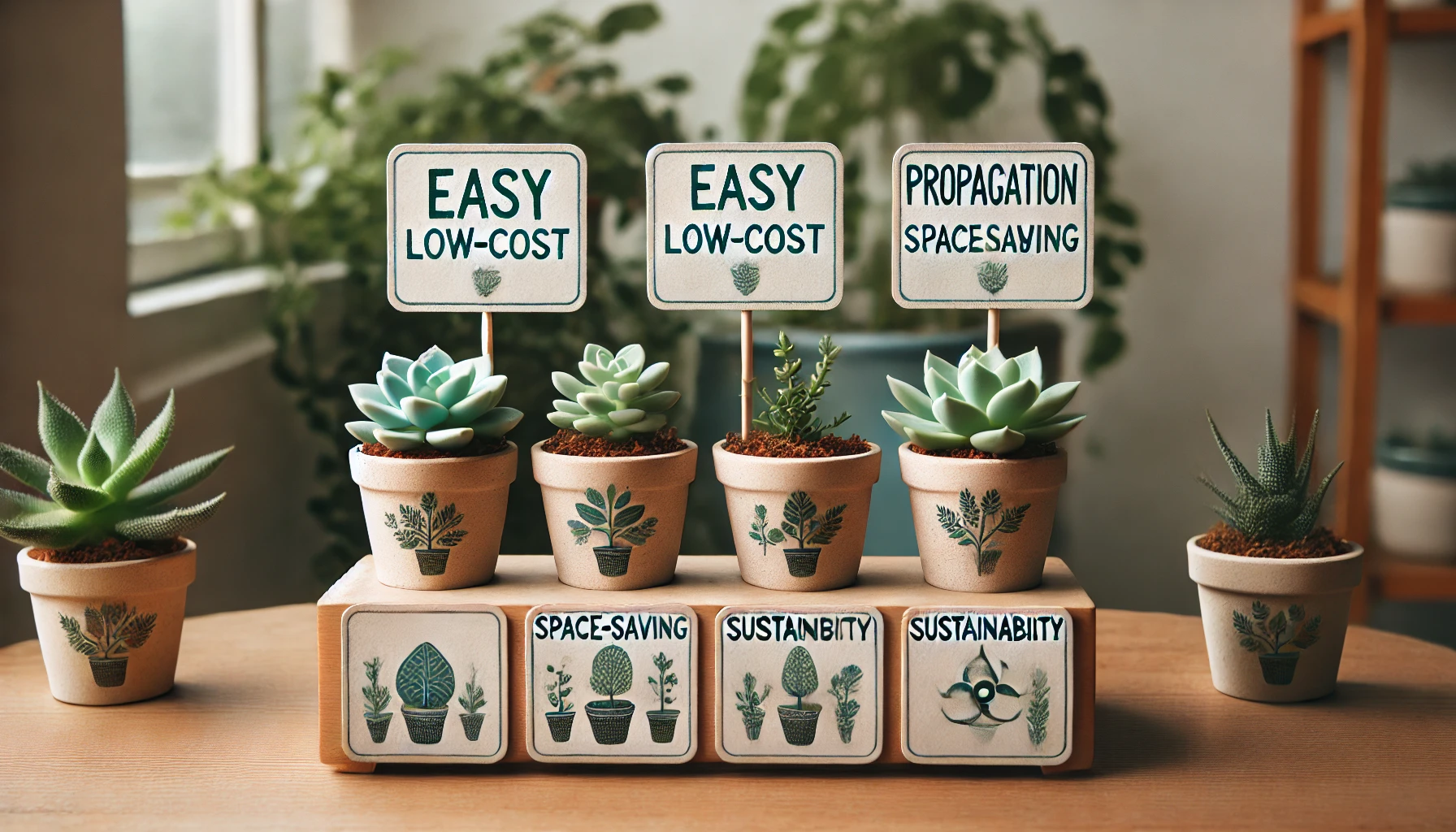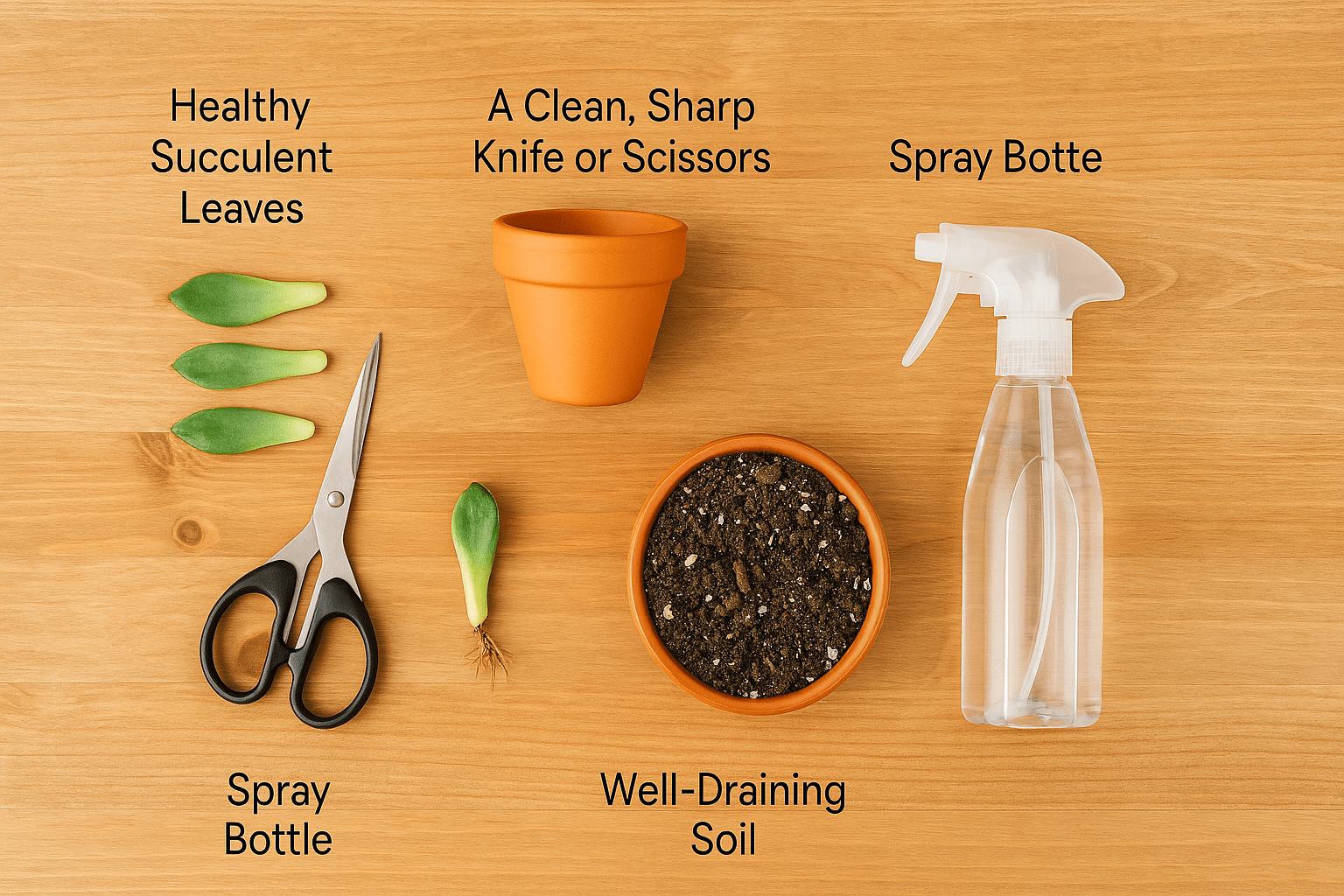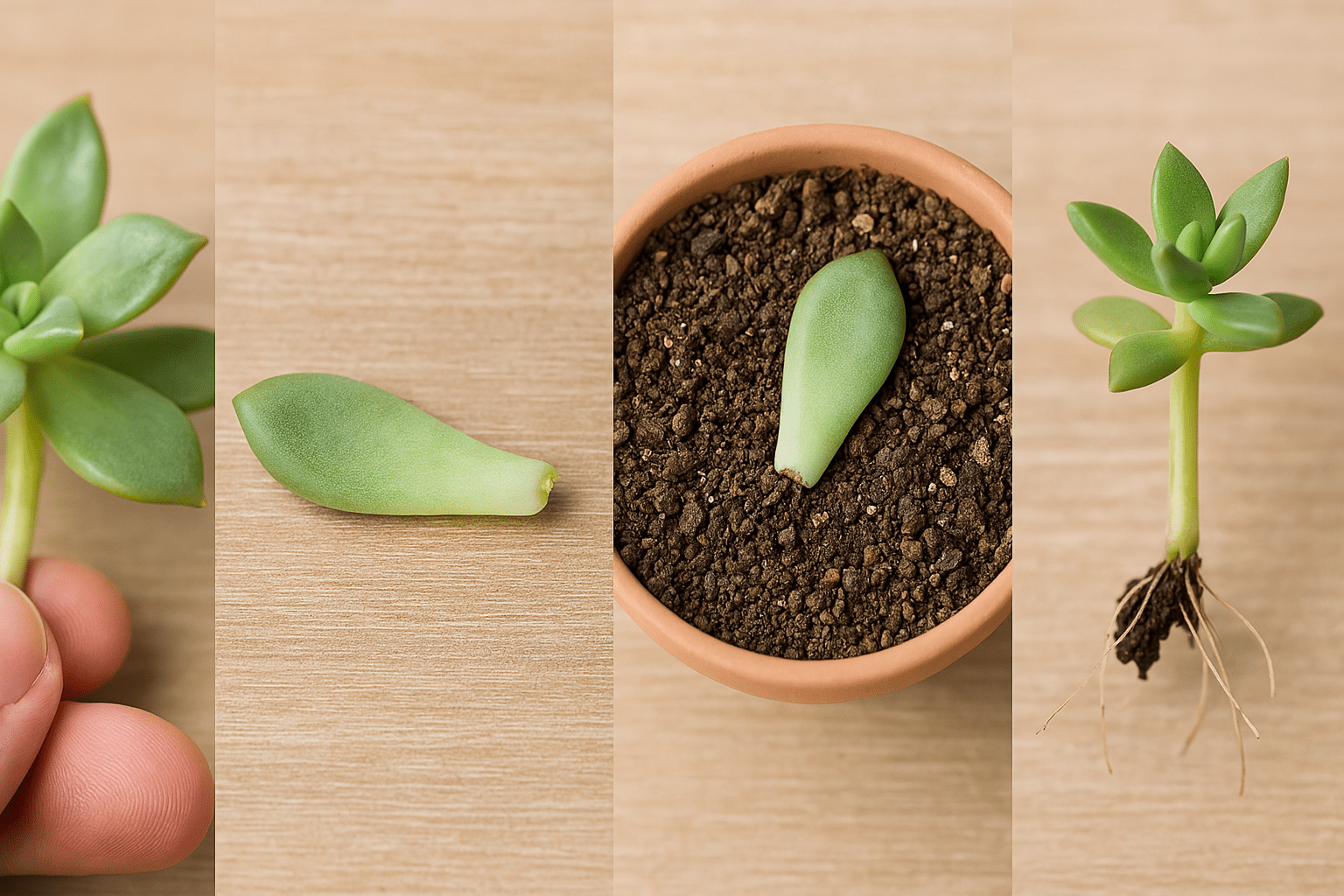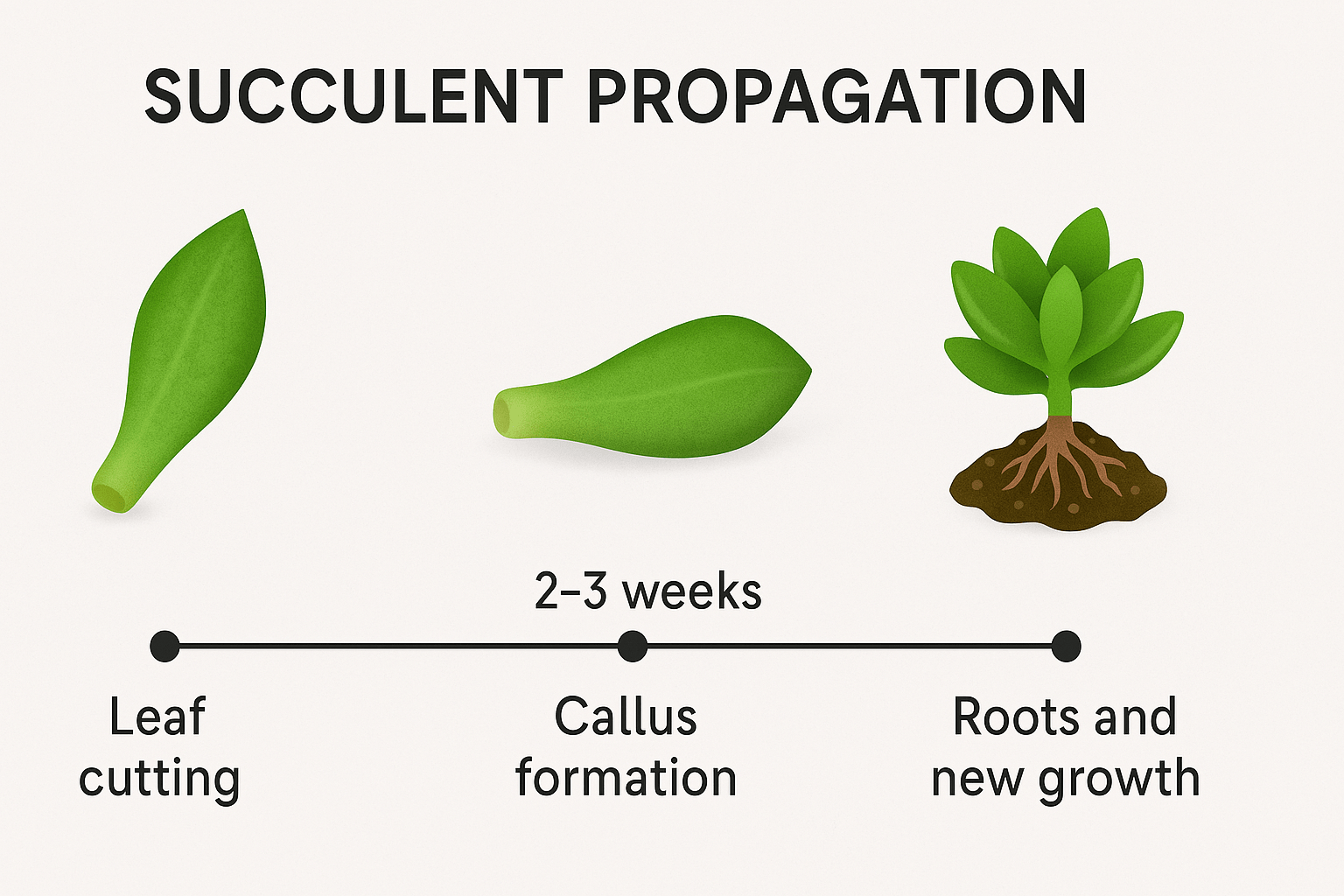
How to Propagate Succulents from Leaves: A Simple Guide for Beginners
If you’ve ever admired the beauty of succulents and wanted to expand your collection, learning how to propagate succulents from leaves is a simple and rewarding way to do it! Succulent propagation is not only an easy way to grow new plants, but it also allows you to watch your plants thrive from the very beginning. Whether you’re a complete beginner or a seasoned gardener, propagating succulents from leaves is an enjoyable and low-maintenance process that anyone can master. In this guide, we’ll walk you through the simple steps to propagate your succulents successfully, ensuring healthy and vibrant new plants every time!
Table of Contents
ToggleWhy Propagate Succulents from Leaves?
Propagating succulents from leaves is a simple and cost-effective way to grow new plants. Here are the key benefits of using this method:

Easy and Low-Cost
Leaf propagation doesn’t require expensive tools or complex techniques. You simply need a healthy leaf, soil, and patience. This method is perfect for beginners and plant enthusiasts on a budget.
Preserves the Parent Plant
By propagating from leaves, you can multiply your collection without damaging the parent plant. It allows you to enjoy multiple healthy plants from one source, ensuring the original plant remains intact and thriving.
Saves Space
Leaf propagation requires very little space, making it ideal for those with limited room. You can start multiple cuttings in small containers, ideal for apartment dwellers or anyone looking to maximize their space.
Sustainability
This method allows you to recycle fallen leaves or those that need trimming, contributing to a more sustainable gardening approach. Instead of discarding leaves, you can give them new life and grow a fresh plant.
Effective for Popular Succulent Varieties
Many common succulents, such as Echeveria, Jade, and Sedum, propagate easily from leaves. This makes it a reliable technique for growing new plants of your favorite varieties.
By propagating succulents from leaves, you not only expand your collection but also enjoy a fun and rewarding process that results in healthy, thriving plants.
Materials Needed for Propagating Succulents from Leaves
Propagating succulents from leaves is a simple and rewarding process, but having the right materials is crucial for success. Here’s a list of everything you’ll need:

Healthy Succulent Leaves
Choose plump, healthy leaves from your succulent plant. Avoid leaves with signs of damage or disease, as they won’t root properly. Make sure the leaves are fully mature, not too small or too large.
A Clean, Sharp Knife or Scissors
For a clean cut, use a sharp knife or scissors. A clean cut helps prevent damage to the leaf and reduces the risk of infection.
Well-Draining Soil
Use a well-draining succulent or cactus soil mix. This ensures proper drainage and prevents overwatering, which can lead to rot. If you don’t have a specialized mix, you can add sand or perlite to regular potting soil.
A Shallow Container or Tray
A shallow container or tray is ideal for laying out your succulent leaves while they callus over. It should have good drainage to avoid waterlogging. This also helps keep the leaves in place as they develop roots.
A Small Pot or Container for Planting
Once the leaves develop roots, you’ll need a small pot with drainage holes for transplanting them into soil. Make sure the pot is large enough for the roots to grow but not too big, as a large pot can lead to overwatering.
A Tray or Shallow Pan for Rooting (Optional)
Some growers like to root succulent leaves directly on a dry surface, like a tray, before placing them in soil. This can encourage callusing and prevent rot. It’s an optional step but can help if you prefer to root leaves without directly placing them in soil.
Watering Can or Spray Bottle
Watering your succulent cuttings correctly is key. Use a watering can with a gentle stream or a spray bottle to mist the leaves lightly, keeping them moist but not soaking wet. Avoid overwatering to prevent rot.
Indirect Light
Succulents need bright, indirect light for healthy growth. Direct sunlight can scorch the leaves, so place your cuttings in a well-lit, shaded spot.
With these materials, you’ll be set up for successful succulent propagation. Keep things clean and patient, and you’ll see new roots and baby plants in no time!
Step-by-Step Process for Propagating Succulents from Leaves
Propagating succulents from leaves is a simple and rewarding process. Follow these easy steps to grow healthy new plants:
Choose a Healthy Leaf
Select a mature, healthy leaf from the succulent plant. Gently twist the leaf off the stem, ensuring it comes off cleanly without tearing. The cleaner the break, the higher the chances of successful propagation.

Let the Leaf Callus Over
After removing the leaf, allow it to dry for 1-3 days in a warm, dry spot. This step is crucial because it helps form a callus over the cut area, preventing rot when you start the propagation process.
Prepare the Soil
Fill a shallow tray or small pot with well-draining succulent soil mix. Succulents require excellent drainage to prevent waterlogging, so choose a mix designed for cacti or succulents.
Place the Leaf on the Soil Surface
Lay the dried leaf flat on top of the soil. Don’t bury it—just place it gently on the surface. Over time, roots and new growth will begin to form at the base of the leaf.
Water Sparingly
Mist the soil lightly with water to keep it moist, but not wet. Succulents don’t like to sit in damp soil, so avoid overwatering. Ensure the soil is slightly moist but never soaked.
Provide Proper Light
Place the pot in a bright location with indirect sunlight. Succulent leaves need light for rooting and growth, but direct sun can scorch them. A few hours of indirect sunlight daily will work best.
Wait for Root and Baby Plant Growth
Patience is key. In about 2-4 weeks, you should notice small roots and a baby plant starting to form from the base of the leaf. Continue to water sparingly and give it light.
Transplant When Ready
Once the new succulent has a well-established root system and a small rosette of leaves, it’s time to transplant it into a larger pot with fresh soil. Gently remove the leaf if it hasn’t fallen off naturally, and transfer the new plant to its new home.
By following these simple steps, you can easily propagate succulents from leaves and expand your plant collection with minimal effort.
How Long Does It Take for Succulent Leaves to Root?
When propagating succulents from leaves, patience is key. The time it takes for roots to form can vary depending on factors like the type of succulent, the environment, and care. On average, it typically takes 2 to 3 weeks for succulent leaves to start rooting.
Here are a few important things to keep in mind:
Temperature and Light
Succulent leaves thrive in warm, bright conditions. Ideally, the temperature should be between 65°F and 75°F (18°C to 24°C), with indirect sunlight. Too much direct sun can dry out the leaves, while too little light slows root development.
Watering Frequency
Unlike other plants, succulent leaves should be left to dry out for a few days before placing them on the soil. Once in the soil, water sparingly. Overwatering can lead to rot, while under-watering can slow root growth. Keep the soil lightly moist, but never soggy.
Leaf Health
Healthy, mature leaves root faster. Avoid using leaves that are damaged, too small, or too old, as they might not root at all.

After 2 to 3 weeks, check for small white roots emerging from the base of the leaf. Once the roots are well-established (around 1 inch long), you can transplant the leaf into a pot with fresh soil for further growth.
By ensuring the right conditions and care, your succulent leaves will root successfully and develop into full-grown plants.
Troubleshooting Common Issues
Even with the best care, propagation in water can sometimes hit a few bumps. Here are some common issues and how to solve them:
Cuttings Rotting in Water
Rotting occurs when the cutting is left in water too long or if the water is contaminated. To fix this, trim away any rotting parts, change the water immediately, and ensure only the lower part of the stem is submerged. If the problem persists, consider using a different container to avoid further contamination.
No Root Growth
If roots aren’t developing, it could be due to insufficient light or too much water. Move the cutting to a brighter location with indirect light, and ensure the water level is just enough to cover the nodes. If the cutting still fails to root, try using a rooting hormone to encourage growth.
Yellowing Leaves or Wilting
Yellow leaves or wilting can be a sign of poor water quality or too much exposure to sunlight. Change the water regularly and ensure the cutting is getting the right amount of light—not too much, but enough to stimulate growth.

Algae Growth in Water
Algae can form in stagnant water, blocking light from reaching the cutting and causing potential harm. To solve this, clean the container thoroughly, reduce the amount of light exposure, and change the water frequently to prevent algae buildup.
Too Many Roots, But No New Growth
If your cutting develops roots but isn’t growing further, it may be time to transfer it to soil. A cutting can only grow so much in water, and the transition to soil provides the necessary nutrients for further development.
By addressing these common issues, you can maintain healthy cuttings and improve your propagation success, ensuring your plants thrive.
Transplanting and Caring for New Succulent Plants
Once your succulent cuttings have rooted and are ready for transplanting, proper care is essential to ensure they thrive in their new environment. Here’s what you need to know:
Choosing the Right Pot
Select a pot with drainage holes to prevent water from accumulating at the bottom, which can lead to root rot. Terracotta or ceramic pots are ideal because they allow the soil to dry out between waterings.

Preparing the Soil
Use well-draining soil specifically designed for succulents or cacti. You can also mix regular potting soil with sand or perlite to improve drainage. Succulents dislike waterlogged soil, so the right mix is crucial.
Transplanting with Care
Gently remove the rooted succulent from the water or previous container. Be careful not to damage the delicate roots. Place the plant in the center of the pot and fill around it with soil, pressing lightly to secure the roots.
Watering After Transplanting
After transplanting, wait a few days before watering. This allows the roots to settle in without the risk of rot. Once the plant is established, water deeply but infrequently, allowing the soil to dry out between waterings.
Providing Proper Light
Place your succulent in a location with bright, indirect sunlight. Succulents love light but can get sunburned if exposed to direct sun too soon. Gradually increase their sun exposure once they are acclimated to their new pot.
Ongoing Care
Continue to monitor the water needs of your succulent. Avoid overwatering, as it’s a common mistake with new plants. During the growing season (spring and summer), you can feed your succulents with a diluted, balanced fertilizer every 4-6 weeks.
By following these transplanting and care tips, your new succulents will adapt quickly to their new home and flourish for years to come.

In conclusion, propagating succulents from leaves is an enjoyable and beginner-friendly way to expand your plant collection. By following the simple steps outlined in this guide, you can successfully grow new plants from just a single leaf. Patience is key, but with the right care, your new succulents will thrive and bring beauty to your home or garden. Remember to give your cuttings plenty of light, warmth, and proper watering, and don’t be afraid to experiment with different succulent varieties. Propagation is not just about growing plants—it’s about building a deeper connection with nature and enjoying the process of nurturing life from the very beginning. So, grab your favorite succulent, get your materials ready, and start propagating today—your new plants are waiting!
Frequently Asked Questions(FAQ)
Can I propagate succulents from broken leaves?
Yes, you can propagate succulents from broken leaves as long as the leaf is still intact and not too damaged. Simply follow the same steps for propagation: let the broken leaf callous over for a few days, then place it on soil to start rooting.
How long does it take to propagate succulents from leaves?
It typically takes anywhere from 2 to 6 weeks for succulent leaves to root, depending on the environment, type of succulent, and care provided. You’ll notice small roots and a baby plantlet starting to form as the process progresses.
Why is my succulent leaf not rooting?
If your succulent leaf is not rooting, it could be due to factors like overwatering, insufficient light, or low humidity. Make sure to provide your cuttings with well-draining soil, indirect sunlight, and minimal watering until roots begin to form.
How often should I water succulent cuttings?
Water your succulent cuttings sparingly. Wait until the soil is completely dry before watering again. Overwatering can lead to rot, so it’s best to keep watering to a minimum until the roots are established.
Can I propagate succulents in water?
While some succulents can root in water, it is generally better to propagate them in soil. Succulents are adapted to dry conditions, so they tend to root more successfully in well-draining soil.
When can I transplant my new succulent plant from the leaf?
Once your succulent cutting has developed roots and a small plantlet, you can transplant it into a separate pot. Be sure to handle the tiny plant carefully to avoid damaging the roots.
What succulents are best for leaf propagation?
Succulents like Echeveria, Jade Plant, Sedum, and Crassula are some of the best candidates for leaf propagation. They tend to produce roots and plantlets quickly and reliably.
Can I propagate multiple succulents from the same leaf?
Generally, a single leaf will only produce one new plant. However, some succulents may produce several tiny plantlets from the same leaf, depending on the species and environmental conditions.
